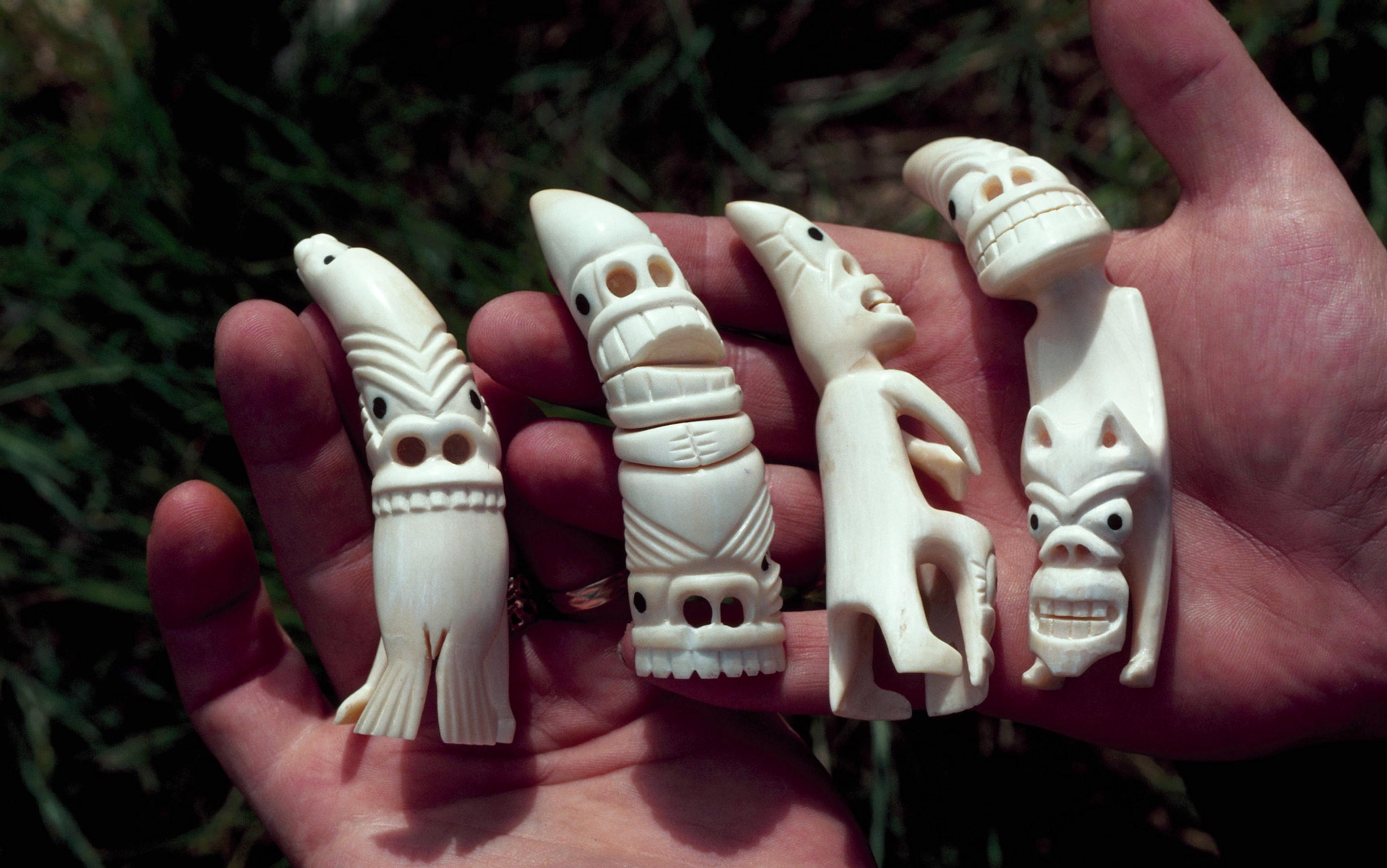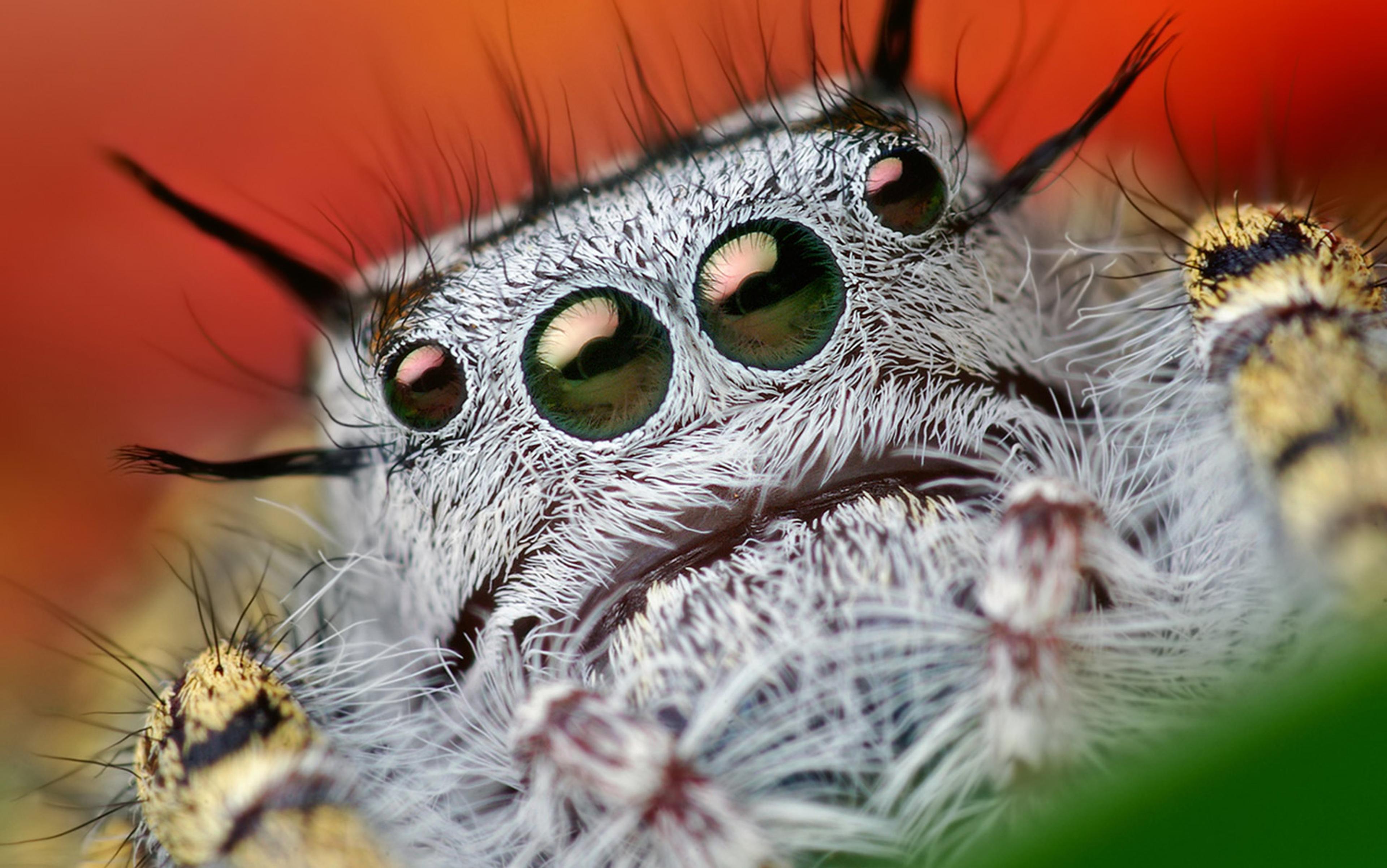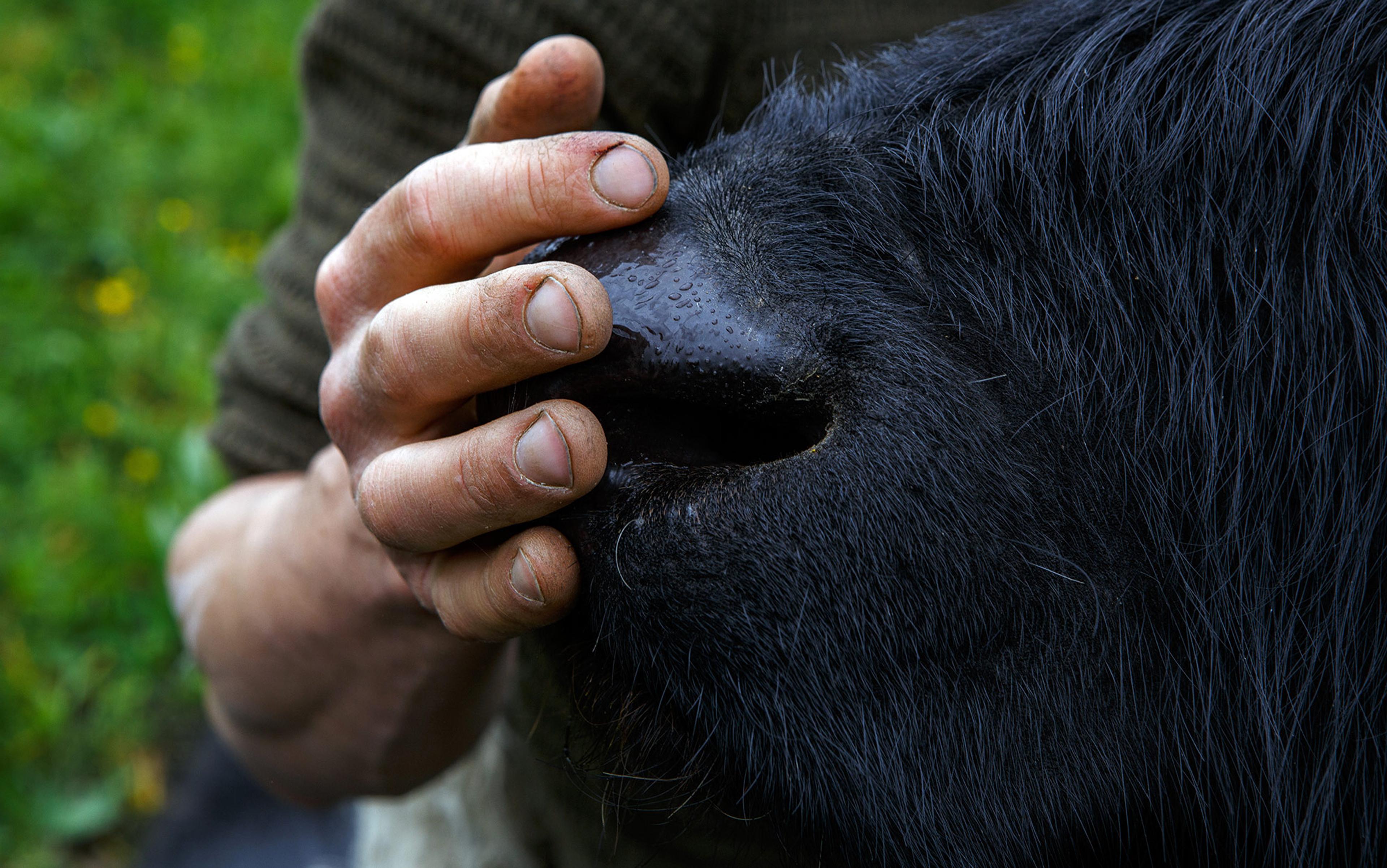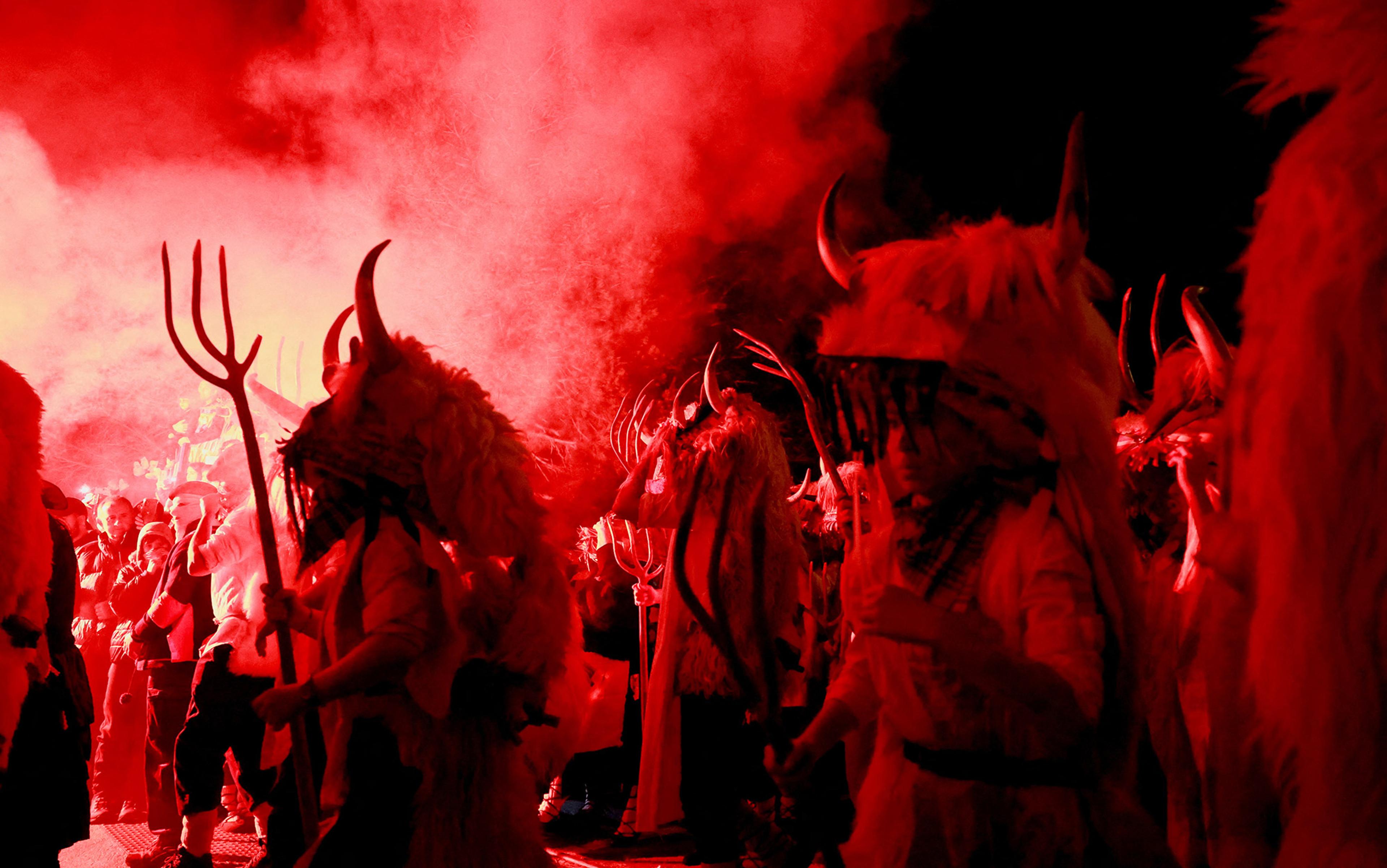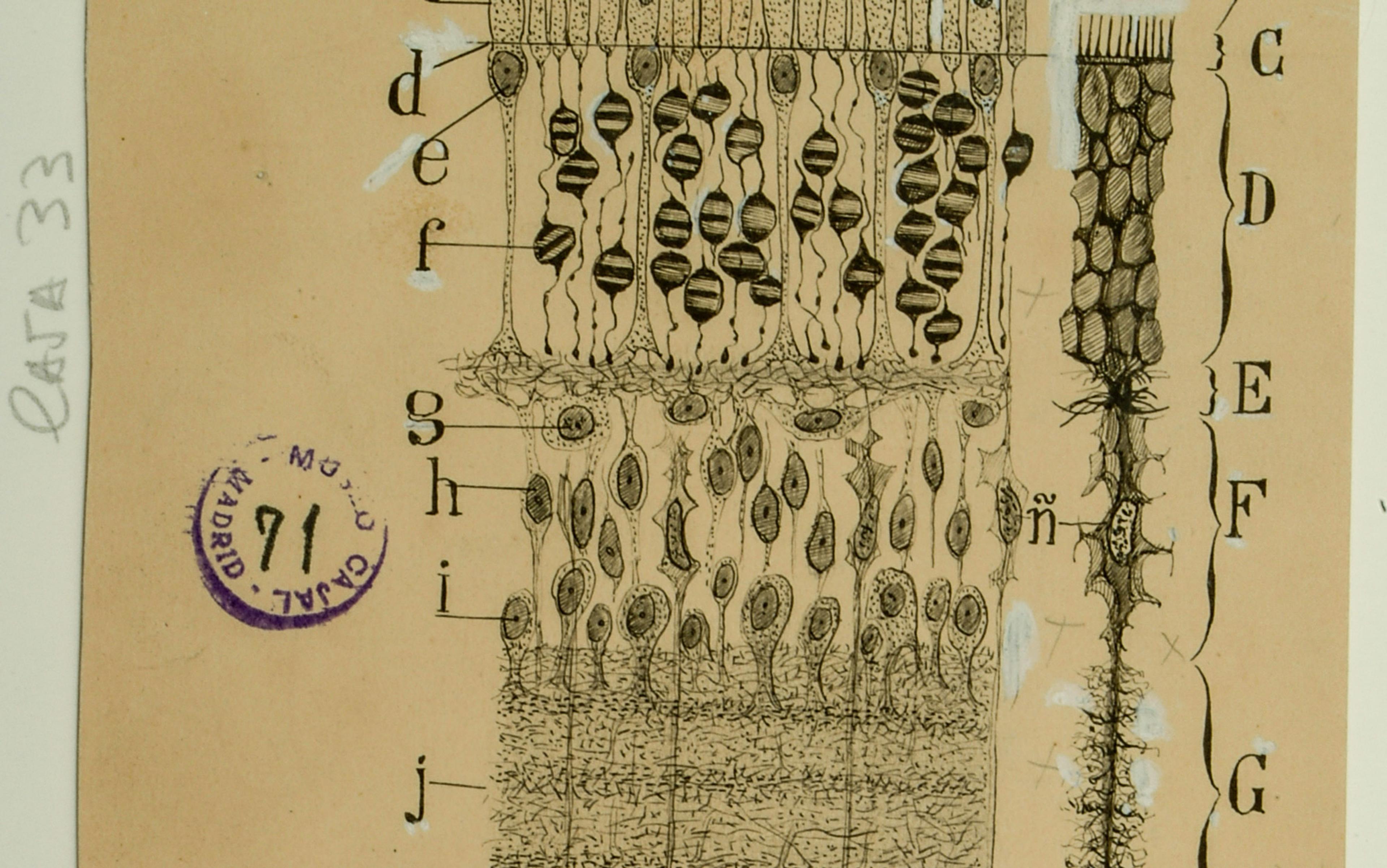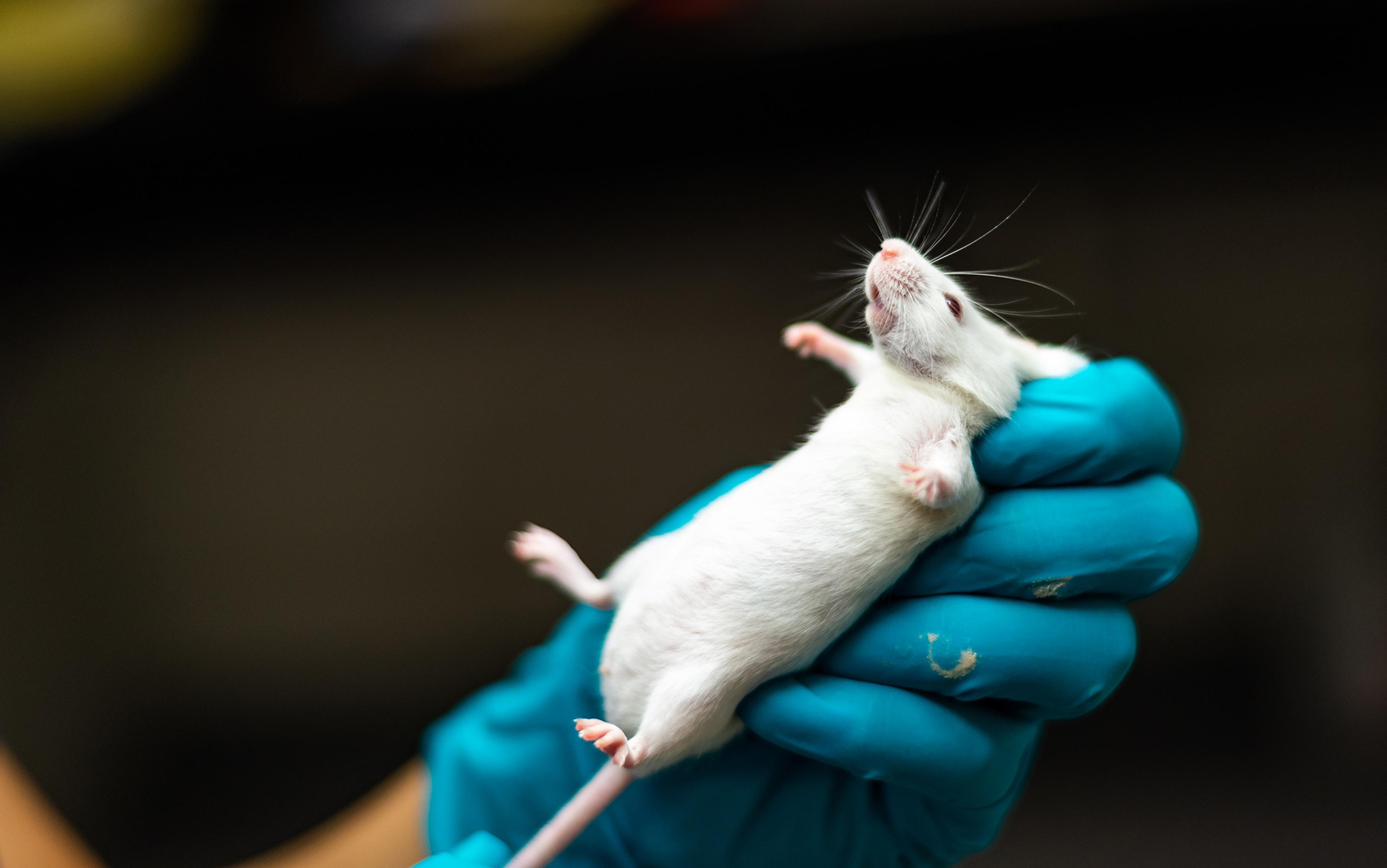I’ve been nursing a gentle obsession with a quartet of bone-white, thumb-sized figurines. I first saw them, lined up in a row, on the cover of Miguel Tamen’s book Friends of Interpretable Objects (2001). They rested in a pair of open hands, looking toothy, and vital, exuding a cool glimmer, while evoking the long Arctic night and the estranging cold. And yet they’re also tiny and personable, these figurines. Their smooth features beckon you to enfold them in the palm of your hand. Their heads are cocked at mad angles, and their leering eyes and rabid smiles bespeak a secret, conspiratorial sociability.
In his book, Tamen contends that objects — art objects in the first instance, but by extension the many things upon which our fascination fixes, such as shells, stones, stars, milk bottles, leaves, and lamps — take up power and life with us as we incorporate them into ‘societies of friends’. The figurines on the book cover present an admirable picture of such a society — antic and charismatic friends, whose secret stories one desires to know.
As it turns out, the figurines are never mentioned in the text. It’s likely the book’s designer chose the image, seizing on this quartet of seemingly interpretable objects without paying much attention to the manuscript itself. The book’s back cover offers a bit of metadata: a caption, which describes the objects as ‘devil figures’ with a provenance of Tuktoyaktuk in Canada’s Northwest Territories. The caption says they were ‘carved from the teeth of a blue whale’.
I haven’t been to the Northwest Territories, and I have never seen a blue whale. But I know that they do not range as far north as Tuktoyaktuk, and I know that they do not have teeth. The objects on the cover of Tamen’s book were likely made from the teeth of beaked whales — dolphins, orcas, and their kin. Perhaps the teeth belonged to belugas, which are still hunted by the Inuvialuit people of Tuktoyaktuk, a remote village in Canada’s Northwest Territories, known in recent years as the northern terminus of one of the wintertime highways in Ice Road Truckers, a reality series for cable TV. Further search turns up a link to the original picture at the image bank Corbis, where the note about blue-whale teeth likely originated; the caption reads: ‘A person holds devil figures carved from teeth of a blue whale, Tuktoyaktuk, Northwest Territories, Canada’. The photo was taken by Lowell Georgia on 1 August 1980; its ID number is LG002968.
These teeth thrummed, their ivory timbre sending songs across submarine canyons and ice-hung plains of shingle
While the caption might err in identifying the carvings as the teeth of a blue whale, it’s not far off in calling them devils. The little ivory characters are examples of tupilaq, a genre of carved critter widespread among the Inuit and other peoples of the far north. The tupilaq that live outside of museum time, outside of gallery time, are evil spirits called into being by a shaman for the purpose of making mischief. They carry curses to rivals and enemies. Made from bone and fur and other materials, the tupilaq are powerful magic — and dangerous for those who wield them, for if discovered, their powers turn back on their users unless an immediate public confession is made. Secrecy and darkness are the native habitat of the tupilaq; they lose their power when exposed to the sociable light.
But I’m not interested in scolding Corbis or Lowell Georgia, whose photo marvellously evokes the capricious spirit of the tupilaq for one who never has been so far north. For now, I’m interested to note the ways in which collectable objects weave shadows and ambiguities around themselves. The light-skinned hands holding the tupilaq in the photo manifest some degree of control over the carvings, but of a kind that can never be total. Objects arrive webbed in connections, and hoard their most intimate gestures and relations in unreachable treasure-houses. A collected object is a kind of vessel, freighted with an irredeemable record of acts and things, inaccessible worlds of sense and event, a tissue of phenomenal dark matter caught up in time’s obliterative machinery.
The tupilaq, after all, were made from the teeth of an animal whose warm blood surged against tide and ice. These teeth dragged bleeding prey into the black, and tore banners of bubbles through holes in the ice. These teeth thrummed, their ivory timbre sending songs across submarine canyons and ice-hung plains of shingle. Torn from the reek on the blood-soaked shore, these teeth were plucked and cleaned and polished, and carved into devils meant to breed bad luck on a neighbour’s lodge, his wives, his weapons. Every gesture, every practice of craft and magic and the secret haunts of commerce, took these teeth into a new domain: out of the carbon cycle and into the symbolic.
Nor quite this, in the end — for any straightforward dichotomy between the natural and the cultural, the material and the symbolic, is complicated at every instance by qualities that refuse neat abstraction. Toothed whales use their teeth for communication; a porpoise’s charismatic smile tells a story; dolphins deploy the acoustic properties of their teeth to issue warnings and threats. Rooted in the jaw, the tooth likely aids a whale’s perceptual work, its capturing and filtering of sound in the marine environment. Forged in an organismic manufactory, tooled by genes (it’s symbols all the way down), a tooth takes its place for a time in a network of perception and action: catching the piercing resonance of whale song bounding in the deep canyons — testing and metering the shifting temperatures of Arctic air — tearing and gripping the trauma-tautened flesh of smolt salmon.
In any case, the ebb and flow of human symbolic culture into which these severed and carved teeth are plunged is never so bounded and legible as our captions and ethnographic accounts propose. These, too, have their tidal forces, responding to the wax and wane of matter and energy, and the disposition of their effects. There is no final shore of culture upon which these teeth make neat landfall; there is only a long-filtering estuary where tide and sign mingle intimately. Drying in the cold wind, a stranded tooth lies on the sand until it marries beauty in some hunter’s mind, beginning a new transit through channels of sense and symbol. And no matter how figured it becomes, by spells and song, or metadata and scholarship, the tooth remains exposed to the elements.
In this fraught landscape of intermingled effects lies a further twist in the tupilaq’s tale, an intertidal eddy: these charismatic ivory carvings are a product of the mid-20th century. Before the advent of an outside market for Inuit art sparked their manufacture, a tupilaq would have been made of perishable and sometimes unspeakable matter (such as the corpses of children), contrived not to represent the spirit but to call it forth. By contrast these friendly, spirited carvings were done at the request of white traders and travellers, who wished to see what the ‘real’ devils — the ones evoked by the dirty, crumbling effigies — actually looked like. These devils were summoned into being by a collision of cultures. Indeed, the tupilaq have long been popular items in the Inuit art trade, where they fetch their makers a tidy price — commerce weaving another veil of secrecy, behind which the tupilaq themselves dance and hide.
I want to understand how things come to take their place — especially in museums and collections — as embodiments of knowledge, artefacts out of time and nature, provoking curiosity and wonder. How they become objectified. The French philosopher Michel Foucault understood the natural history museum as a kind of republic of objects fixed and ordered in their relations. Of course, those relations change with changing science; yesterday’s taxonomic specimens become today’s harbingers of climate change. This is not to say that the specimens are not friendly to science, that they cannot help us to tell stories about the world. But I want a museum with the modesty to realise that the objects of its interest do not take their sole, true, or final form beneath its gaze. As seen by science, objects withdraw their auras — burning coronas that connect sense and experience to the deep past — and when the galleries and museums are in ruins, they will expose new banners to time’s unfolding. The tupilaq are players in a luminous, long-durée ecology — one in which paintings and pelts, sculptures and scarab beetles, clay pots and crania change states and meanings; negotiate mingled dimensions of nature and culture; and become consumed, even as they consume our attention.
While at college, I landed a work-study lab-assistant position at the Field Museum of Natural History in Chicago. I found this an immensely exciting prospect: the Field Museum (in particular its dinosaur skeletons and its collection of totem poles) had loomed large in my childhood understanding of science, as did natural history itself, as a way of organising experiences of the world. Of course, it was live animals I wanted to get close to — the more charismatic the better — but, unlike the lives they seemed to lead in classic nature documentaries (the kind of close-up ecology depicted in the pages of National Geographic magazine), animals in nature were thinly distributed, cunningly hidden in the fields and mud-smeared woods near my childhood home. I had relished visits to the Field Museum: it seemed a place of dense variety, in contrast to which the wider world — at least the part of it I found growing up in the patterned fields of Central Illinois — seemed diluted, intent on hiding tiny quantities of insight and wonder amid swirling, monotonous tides of grey and green.
My job at the Field Museum was in the Mammals Division, working in the specimen-prep lab. The job took me deep into the backstage world of the curatorial departments, a naphtha-scented realm of dioramas and musty cabinets, entered by way of a cunningly hidden elevator behind the colonnade in the museum’s enclosed façade. Stepping out from the elevator, one emerged into a long, dim corridor where museological tools such as disused vitrines and dusty signs were deposited. The specimen-prep lab, a warren of bright rooms off the corridor, hosted an array of familiar laboratory gear — a fume hood, a steel dissecting table, lab benches cluttered with Pyrex glassware, pipettes, and sturdy boxes of smooth-textured cardboard.
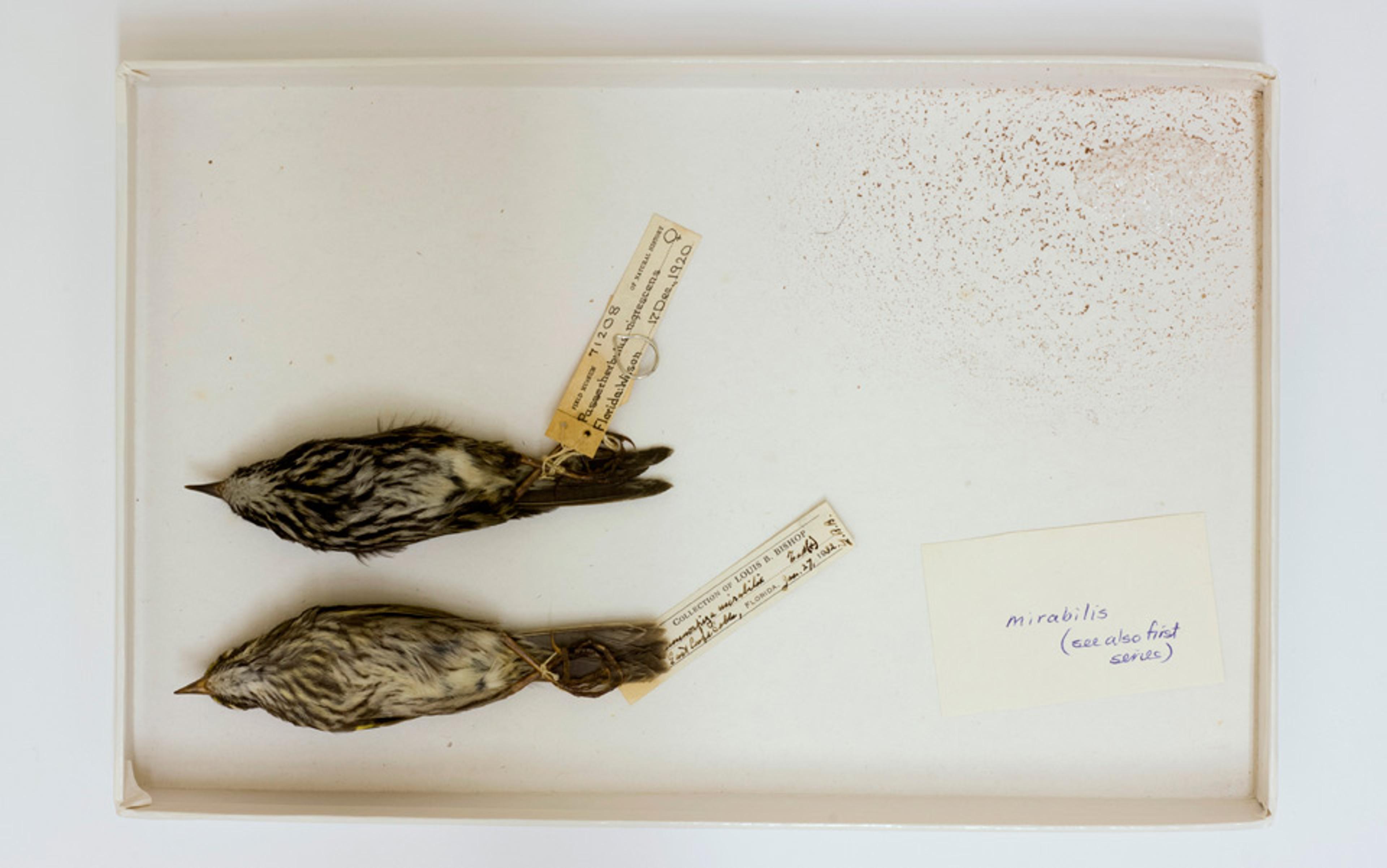
Dusky Seaside Sparrow specimens at the Field Musuem, Chicago. Declared extinct in 1990, by 1980, six remaining individuals, all males, had been captured to establish a captive breeding programme. No females were ever found. The males lived out their lives in a Walt Disney World nature reserve called Discovery Island. The last died in June 1987. Photo by Marc Schlossman/Panos
There were distinctive furnishings as well: in particular, the maceration tank, a giant stainless-steel pot on a pedestal, a huge pressure cooker used to boil large specimens down to bones. And, behind an airlock-like set of self-sealing doors, the dermestid room — named for the swarms of beetle grubs that seethed over small skeletons, picking them clean. Outfitted with variously sized glass tanks full of grubs, this room was a secure space, with blowers supplying negative air pressure, and seals around the doors, to ensure no beetles or larvae could escape. Upon leaving the dermestid room, you had to stand in the airlock and brush down your clothes. There was an aroma of putrefaction in the room, but it was faint — you got used to it. The sound, however, was oppressive. The place hummed with a static song of tens of thousands of beetle grubs, hairy and grey, all chewing at sinew and dried muscle.
The holotype is a heady, almost absurd designation: an animal sacrificed to represent a life form in its entirety, its desiccated skin and loose, lacklustre fur or feathers standing as avatar for the flashing, teeming, endlessly various individuals of the species
Our task in the specimen-prep lab was to transform dead animals into data. The products of our work were not the taxidermied simulacra that posed behind glass in the galleries, but study skins and skeletons for the research collection. These were stored out of public view in open-topped archival boxes, which fitted closely together into broad, shallow trays that rested in rank upon rank of shelving, forming a library of the dead. Although to call the specimens dead does not sound quite right. For the specimens had transcended or exceeded death, had passed beyond its dominion by means of a process that arrested, ostensibly in perpetuity, their participation in the carbon cycle, the wheel of disarticulation and recombination, that is life on earth.
The collection was not comprised of equals. Enjoying pride of place among the trays were the holotypes, singled out as exemplars of their species. Set off by their yellow tags, type specimens are often much older than their preserved confreres. In most cases, they document the discovery of a species — although of course they’re rarely discoveries in the strict sense of the term. Instead, they’re symbols of a species’ scientific acknowledgement, of the moment when a local variant achieves a Latin binomial and a place in a refereed journal. The holotype is a heady, almost absurd designation: an animal sacrificed to represent a life form in its entirety, its desiccated skin and loose, lacklustre fur or feathers standing as avatar for the flashing, teeming, endlessly various individuals of the species.
However, in dialogue with the singularity of the holotype, it is the specimens in aggregate that give voice and scheme to variety. Any given tray of specimens both expresses and effaces vital relations among discrete creatures; a tray of voles might have all been collected in the same forest or glacial basin, where they comprised a community of bodies jostling, mating, and competing with one another. Other specimens lying nestled together in a case, by contrast, might never have run across one another in life. Now pristine, beyond birth and death, predation and putrefaction, they offer themselves up as information, an apposition of time and place with diameter of nostril, length of genital vent, and body weight in grammes. All of these data gather to sketch the shapes those vital relations take, the specimens in death comprising a kind of rump parliament of the abstract.
We in the lab, too, were specimens of a type, denominated ‘preparators’, the inflection of the neo-Latin -ator conferring our place, substantial albeit subordinate, in a guild hierarchy. However, it’s the ‘prep’ that captures my attention now for its reformulation of this mortuary processing, this penultimation, as something prefatory or prior. Through our craft, we preparators erased all traces of the troubling carnal processes by which furtive or formidable animals had been reduced to things. By cutting and pulling, stretching and cleaning, we set the clock back to zero.
I want to recall the procedures, the precise craft methods, by which we made such data from the dead. Many of the specimens we received were roadkill, swept up by highway work crews and game wardens. Often in the morning, we were greeted by a fresh delivery of dead birds and bats — a donation of McCormick Place, the vast, glass-clad conference centre on Chicago’s lakeshore, whose dusky windows met windblown migrants with unforgiving solidity. We placed these winged specimens in individually dated bags and tossed them into a freezer for later processing. I was especially taken with road-killed fishers, mustelid carnivores of the northern Midwest. Not found in the southerly woods where I grew up, these dog-sized weasels seemed breathtakingly wild to me — even in their frozen morbidity, their ragged costume of matted fur, blood-filled nostrils, and opalescent eyes.
The limbs I would unroll from their sleeves of skin and fur down to the joints of the feet; then some cunning work to liberate the delicate leaf of the digital bones from its external glove of paw
The work of preparing a study skin consisted in several discrete steps. Take a kangaroo rat recently arrived from the Brookfield Zoo: now carefully thawed, still cool from the refrigerator, it lies on the steel table in a loose, parenthetical curl. After first making a series of measurements — length of body, tail, and foot, weight in grammes — I would write out a tiny tag with the relevant geographical coordinates, date of collection, and all-important accession number, all inscribed with an indelible rapidograph pen. Before arriving in the museum, specimens collected by scientists in the field had already been subjected to a great deal of informational dissection: external parasites identified and censused, blood and perhaps other tissue samples collected, and finally, the subject itself euthanised and frozen. But in any case, it was my act of inscription in the prep lab that marked the crucial divide, serving as a scientific sacrament by which the transformation into data was signified and enacted. The dead animal was no longer roadkill, no more the victim of snare, trap, or suffocation; it had been accessioned, its death subsumed in the act of collection.
The transformation, however, was far from complete. Next, I would make an incision from the breastbone to the genitals, taking care not to cut through the abdominal wall. Slipping gloved fingers between skin and fascia, I began tediously to work the intact inner body free from the pelt and out the ventral slit I had made. The limbs I would unroll from their sleeves of skin and fur down to the joints of the feet; then some cunning work to liberate the delicate leaf of the digital bones from its external glove of paw. A great deal of care needed to be taken as well around the facial features, detaching them gently from the skull, trying to avoid leaving a fringe of hair attached near the brows, or a tear in the soft nasal tissues.
Invariably, there were lost pieces of information: tiny shreds of pad or fascia that stayed adhered to bone as the rest of the animal’s exterior was torn loose from its sinew-clad skeleton. Often, the extremities would be cut away at the distal ends of the long bones, the paws left intact to hang heavily from the hollowed-out skins. The tail, too, needed tedious unworking from its sleeve of hide — a slow peeling back, bone by bone, to free the pink-sheathed caudal vertebrae, without turning the skin inside-out. A loose sock, a sketch, a gesture vaguely allusive to animality, the skin would now be filled with cotton-wool and pinned out to dry. Organs plucked free, the sticky, flayed rack of bones would then go into the dermestid room to commune with the beetles.
For all its systematic nature, our work bore a family resemblance to that of the shaman fashioning his tupilaq: in the prep room, we transformed ephemeral animal matter into storytelling objects. Accessioned, tagged, and arrayed in their boxes, the skins and skeletons were meant to fix and identify connections that bespoke genetic and geographical variation; they were artefacts of phenotype extended in space and time. Likewise, the tupilaq carving is never complete and self-sufficient, but exists as a node, a kind of handhold in a route tying together predation and consumption, spells and songs, the pulses of beauty and value that push it through markets and museums. The prepared specimen, too, acts as a kind of node, articulating its position by way of triangulated theory and data, drifting along tidal shifts of paradigm and intellectual purpose.
Of course, the texture of that tale of variation shifts through time. Natural history museums have never been monolithic, but have changed with the social and institutional make-up of science and its audience, from early modern cabinets of curiosity, to disreputable dime museums, to neoclassical forums for public edification. The Field Museum is of this last type. Founded in the wake of Chicago’s 1892 Columbian Exposition, it expressed the epistemology of natural selection in its post-Victorian incarnation: variation unfolding in stately, steady grandeur, an ordered autotelos reified in row upon row of mothballed specimens. The advent and acceptance of Mendelian genetics; the growing influence of biogeography; the discovery of DNA, the rise of systematics, genomics, and computational biology — all of these are so many subtle and shifting re-readings of the collection, stories wrung from desiccated data, spirits evoked by these effigies of natural history.
In its ordered cabinets, the specimen collection superimposed and coordinated two different kinds of space. On the one hand there was the hierarchical logic of the classification scheme: specimens disposed throughout in boxes, sliding shelves, and jars according to the taxonomy, from kingdom to class to specific epithet. Intersecting this paradigmatic plane was a geographical dimension evoked virtually, via metadata, with each specimen’s place of collection tagged and noted. Ideally, these two planes interacted in the museum like a multidimensional slide rule for natural history — one calibrated and operated by teams of expert operators, from lab techs to curators to field scientists.
As museums emerged as research institutions during the 18th and 19th centuries, Georges Cuvier championed the epistemic leverage of these centrally coordinated spaces of natural history. From his seat as professor of animal anatomy at the Muséum national d’Histoire naturelle in Paris in the late 1790s, Cuvier argued that the observations of the naturalist in the field ‘are broken and fleeting’, compared with the powers of the sedentary savant:
The sedentary naturalist, it is true, only knows living beings from distant countries through reported information subject to greater or lesser degrees of error, and through samples which have suffered greater or lesser degrees of damage. The great scenery of nature cannot be experienced by him with the same vivid intensity as it can by those who witness it at first hand … If the sedentary naturalist does not see nature in action, he can yet survey all her products spread before him. He can compare them with each other as often as is necessary to reach reliable conclusions … The traveller can only travel one road; it is only really in one’s study (cabinet) that one can roam freely through the universe …
The objects disposed in the cabinets of natural history are varied in their qualities and their uses: not only study skins and skeletons, but whole creatures preserved in jars of alcohol, germ plasm samples in cryogenic tubes, and sundry other accessions. For purposes of natural science, specimens represent ‘raw’ data. Indeed, the term ‘preparation’ serves to ‘re-raw’, so to speak — for, like the tupilaq, the dead animals are already thoroughly ‘cooked’. And like the tupilaq, they are doubly mysterious.
All the alien, zooic qualia of an animal’s life — each living creature’s unique contexture of sensations and responses, their breeding successes and failures, their urges bred from fear and separation and prey-drive — all these have been irredeemably eradicated in the natural history collection, left behind at the snap of a snare, rinsed down the steely drain of the prep lab’s necropsy table. Via the same fraught and tedious techniques, they are reinscribed, transformed into esoteric texts that are unreadable without peculiar stores of training, tacit knowledge, and craft practice. The stories they tell, the truths they were meant to exhibit and enact, are nowhere self-evident. An act of predation subsumes and reincorporates phenomenal animal affordances; the scientific sacraments of collecting and accessioning, by contrast, call forth abstract and motive truths, just as the expertise of the shaman reveals and directs the powers of the tupilaq spirits.
‘Relay #70 Panel F/(moth) in relay,’ reads the journal; below, in what is likely Hopper’s hand, the line ‘First actual case of bug being found’
Recall that in making the tupilaq, the shaman submits to a special code of secrecy: if the effigy is discovered or its influence identified, only his immediate public disclosure of the transgression will keep the spirit from turning back on the shaman and his client. The scientist, perhaps, assumes a similar burden in the cycle of knowledge production and publication. The promise of these acts and the artefacts they produce — monographs, journal articles, research bulletins — is the burden of responsibility laid on the museum’s scientific community by the collection. Unavoidably, or so it seems, these activities demand further acts of collecting and accessioning, which serve to keep the cycle in motion, the spirits restlessly on the move.
In other kinds of museums, objects on display stand for the dark matter of the collection in storage. They are tokens of riches withheld — the vast stored collection not on display but catalogued and preserved as semiotic insurance in the vault. Natural-history collections (in particular those devoted to ecology and evolution, the paleontological and zoological collections) consist almost entirely of objects categorically unsuitable for display — objects that, like the tupilaq, derive their value and agency from the esoteric and out-of-sight dynamics calling them into being.
Bewitched with thoughts of specimens and effigies, I recall yet another object that serially catches my fancy: the ‘first computer bug’, an archival curiosity collected during the Mark II computer-science research project led by Howard Aiken at Harvard in the mid-1940s. The Mark series was produced in a research programme driven in large part by the brilliance of the American programming pioneer Grace Hopper; the Mark II was one of its early electromechanical computers, instantiating computational logic in a vast, greasy array of switches, shafts, and clutches. Hopper and her colleagues kept a log of their programmatic experimentation, ordering by date and time a journal of the instructions they fed into the machines and the results returned, with terse notes detailing breakdowns and other machine behaviours. Typical lines read ‘0830, Started machine’ and ‘6th degree polynomial Registration trouble most of morning’.
In effect, the logbook, which resides in the Smithsonian’s Museum of American History in Washington DC, is a record of early computer bugs rendered in precise, empirical terms. And in those records, one bug stands out: on page 92, at 1545 on 9/9 1945, an actual moth was fixed to the page with a piece of tape. ‘Relay #70 Panel F/(moth) in relay,’ reads the journal; below, in what is likely Hopper’s hand, the line ‘First actual case of bug being found.’ In record photographs of the journal book, the moth is desiccated, the tape yellow and wrinkled.
Looking for guidance on the nature of this specimen, I wrote to the evolutionary biologist E O Wilson, whose seat as professor at Harvard’s Museum of Comparative Zoology offers an ideal vantage from which to survey the status of this first computer bug. ‘I’m looking at an object in the Smithsonian that purports to document the first computer “bug”,’ I wrote to him in an email. ‘I’m interested in the moth as a kind of type specimen … More broadly, I wonder if the “bug” might make an interesting object to muse upon tensions between technology and the natural world — and I’m sure your reflections on such a connection would be invaluable.’
It’s clear that engineers working on the Mark II were familiar with this usage; the ‘actual’ bug was entered into the log as a cheeky aside, a bit of lab humour
A couple of weeks later, Wilson sent me a reply. A quarter century or more ago, he wrote, he had asked Hopper herself about the fate of this ‘national treasure’, the first computer bug; she had reported that it had gone to the Naval Museum in Washington. Wilson encouraged me to track it down wherever I might find it, and to get an entomologist to identify the species of moth. And, ‘if in the process you can euchre it out of whoever has it,’ he concluded, ‘and bring it to Harvard’s Museum of Comparative Zoology, you will be a local hero.’
I doubt I’ll be able to pry the bug loose from its current home, the Smithsonian — and in any case, I’m not sure it would be curatorially fitting to do so. For in fact, Hopper’s moth is not the first ‘computer bug’, nor does it furnish us with the origin of the term. Already in the late-19th century, technicians in Thomas Edison’s lab were using the word ‘bug’ to describe thorny technical problems. From the syntax of Hopper’s notes in the journal, it’s clear that engineers working on the Mark II were familiar with this usage; the ‘actual’ bug was entered into the log as a cheeky aside, a bit of lab humour. Bug is an ancient word, and its use in specific reference to creeping arthropods dates only from the 17th century, according to the Oxford English Dictionary. Prior to that, the word named the nameless: bugbears, monsters and creatures of mystery and shadow.

‘First actual case of bug being found’. In 1947, engineers working on the Mark II computer at Harvard University found a moth stuck in one of the components and pasted it into the operational logbook. Photo courtesy Naval Surface Warfare Center/Smithsonian
The moth that blundered into the uncanny machinery of the Mark II, following who knows what tracery of heat and light, was of no particular natural-historical significance. Furtive in its shabby grey fluttering, it would have roused no more than a raised eyebrow from Hopper and her busy colleagues servicing the Mark II — a momentary pause, a dropping of cigarette ash on the console. Only later, upon its post-mortem discovery, was this dead creature turned into data. Now roughly preserved and enshrined in the Smithsonian, the dead insect serves as holotype for the computer bug. Like the tupilaq, computer bugs are ungovernable spirits evoked by a kind of transubstantiation. As the uncanny architecture of the computer unfolded itself in Harvard’s labs, the bug found its way not only into the machine’s works but into a new role as an object in our midst — a role that took its place among the object’s other histories and meanings, its penumbra of qualities.
This patterned assemblage of purposes, roles, and given characteristics, this accidental and ephemeral fate, I want to call by the name habit. An effigy, an insect, an animal’s measured, pinned-out pelt — we have our ways of domesticating these objects, of bringing them to ground, fixing them in amber or in print. The precise practices vary with what habits we bring to bear (from science to shamanism) and the collections they inhabit. And here is a clue — for dwelling in the word ‘inhabit’ is ‘habit’ itself. What if the habits in question are not ours, but those of the objects themselves?
A habit is not only a way of acting, but also a costume of a kind. Some objects — books, dice, celery stalks, lens caps — have deeply ingrained habits, while others — seashells and stars, perhaps, but also bottlecaps, icicles, and plastic six-pack yokes twirling in the mid-ocean gyre — wear their habits more lightly. And some objects take on the habit of naphtha and indelible ink, of cotton wool and alum, of cabinet drawer and taxonomic order.
The word ‘habit’ catches for me a sense of the shoddy assortment of qualities that knits an object into the fabric of things, weaving into one whole its social roles, the cultural codes it keys, and its whence-and-whither entanglements with deep time.
I opened the freezer and was greeted by an earsplitting call: a kind of wet stridulation at the far end of hearing, its frequency so high it seemed to bore into the jaw. It was the cry of something alive
In its particular death, the Mark II moth took up its own habit of data, clothing itself in the raiment of anecdote and explanation. But had it seen its selective mission — depositing eggs in the folds of Hopper’s wool coat hanging from a hook in a Harvard lab, only then to gently expire in a dusty corner — had it escaped to be snatched by a bat, one like those who smashed into the windows of Chicago’s McCormick Place with heedless abandon — in these or any myriad number of alternative cases, its habit would have taken different form and colour. Yet the story of any such habits will in the long run prove as ephemeral as the moth’s wings, trapped like shattered kites beneath the cellophane.
Grace Hopper’s moth became the holotype for the computer bug in an instance of creative misunderstanding, betokening our need for clues, artefacts, and documentation. It’s tempting to see the whales’ teeth in a similar light — the blue whale, after all in its vast placidity and inscrutability offers a tempting totem, a synecdoche of oceanic feeling. And perhaps the moth in the machine furnishes a way to re-nature the computer, to redeem life’s agency in the midst of computation.
Once, at the Field Museum, a specimen managed to doff the peculiar mortal habit of data altogether. In the prep lab one morning, I opened the freezer and was greeted by an earsplitting call: a kind of wet stridulation at the far end of hearing, its frequency so high it seemed to bore into the jaw. It was the cry of something alive. I began to dig through the piled-up paper bags of frozen specimens, spilling them in heaps on the tiled floor. Finally isolating the bag from which the plaintive alarm issued, I found a little brown bat — a winged walnut pulsing rapidly with breath, alive but too cold to fly. It had arrived with a shipment of window-broken birds from McCormick Place the previous afternoon, some 12 hours before.
It’s telling that I struggled with the question of what to do — after all, the bat still was a specimen. Or was it? It had been collected; it was on the threshold of preparation. And yet its vital determination exceeded the bounds of the relevant rituals. Eventually, my prep-lab colleagues and I reached a suitably scientific-seeming conclusion: a bat that survived the night in our freezer was a bat that ought to have another chance at the gene pool. And so we found a window overlooking Lake Shore Drive, cracked loose its long-disused latch, and held the bag open in the wind. After a long moment, the bat fled in a blur, disappearing into Chicago’s booming late-autumn breeze. It disappeared into the invisible cabinet of its unmeasured curiosity, its habit secreted in the wind.
